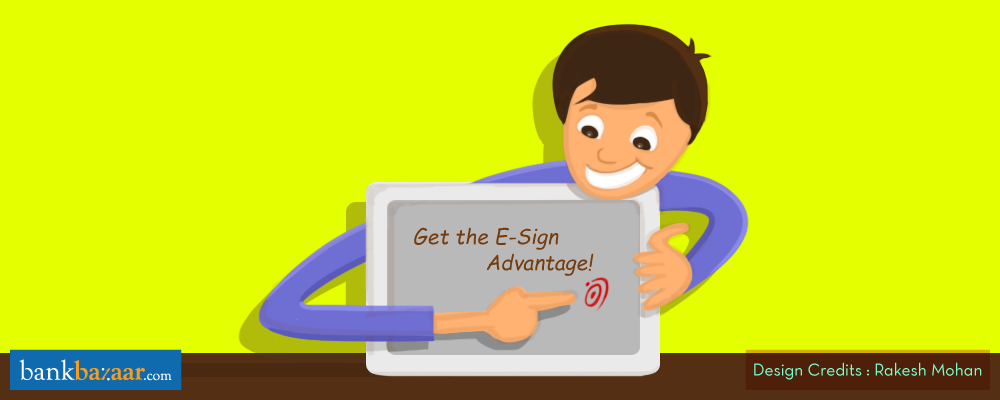
Well, the ruling party has indeed lived up to its promises and introduced sweeping changes throughout the country. Now, whether all of them are for good is a discussion for another day. While most of us are awaiting ‘Ache Din’ with bated breath, the Modi government has definitely made great strides in its Digital India Initiative.
At first, it was the Aadhaar Card and now it’s the e-signature. E-signature?
Yeah, all of us have heard about it, but a full understanding of the topic still eludes us. This article aims to clear the air of confusion around e-signatures and how you can use your Aadhaar details to e-sign documents. You heard us—no more pen and ink. Just like you do everything else online, you will henceforth sign online.
Additional Reading: Aadhaar Based e-KYC: All You Need To Know
First, allow us to tell you how e-sign works
You must have heard two terms – electronic signature and digital signature. Though they may appear to be the same at first, they are, in fact, different.
An electronic signature can range from a scanned image of your signature, a mark made on a computer screen using a stylus, voice signature, your initials, to the tick sign that appears when you click on ‘I agree’. (Now, did you know that every time you clicked on that little square box next to an ‘I agree’ document, you were leaving behind your digital footprint? A little trivia to show off to your friends.) Essentially, an electronic signature is a digital mark in any form.
A digital signature is a subset of the electronic signature. Unlike an e-signature, a digital signature is unique to you and is a strong proof of your identity. Just like your fingerprint is unique to you, your digital signature is unique to you. Hence, it’s thoroughly encrypted for security reasons. To each its own, you know! Since a digital signature links itself to every binary bit of your document, it’ll get very difficult for an evil mind to make changes to your document once you have signed it.
Phew… with that done, it’s time to explain how you can e-sign with your Aadhaar details.
It’s ironic that to get a digital signature you have to fill a paper form and sign it in ink. Ancient! You are then issued a dongle which contains you digital signature with all the relevant certificates and keys. Blah, blah, blah… Skip it. You don’t need to worry about it if you are an Aadhaar-Card holder.
The next time you need to e-sign documents, the institute which requires your signed documents will most likely take your Aadhaar details and issue an e-signature to you. Institutes which navigate a world of paper every day are most likely to offer you this service. They could be government offices, banks, etc.
A few days ago, Axis Bank launched the e-signature service for its customers. Taking a step towards paperless banking, Axis has made provisions for its customers to e-sign their applications. If a bank’s doing it, you know an e-signature is legally valid and secure.
How does it work?
In the case of Axis Bank, they have tied up with an e-signature provider. Once the bank receives your Aadhaar details, they will verify it and ask the e-signature provider to issue a digital signature for you. Sounds like a long procedure? No, all this happens within minutes.
Once you have your e-signature, you can digitally sign your document. What’s more, you can also use your e-signature to create and access Digital Lockers; another brainchild of the Digital India Initiative. Digi Lockers allow you to save important documents online. With time, you will be able to e-sign all digital documents with your e-signature (tax documents, passport or driving license papers, etc.)
How will I benefit with an e-signature?
It’ll give you the powers to be a Jedi Knight. Yes, it will. You can submit signed documents online without touching a pen or a pencil. Here are some of the other benefits.
- It’ll save you a whole lot of time. No more downloading online forms, then signing them, and then uploading them. If you have an e-signature, just click! Your documents will be signed, sealed and sent.
- Don’t worry, nobody can tamper with your document once it’s signed! The signature works like an encryption code. Without you authenticating any change, tampering with your documents will be a hard nut to crack. Ask the CIA, if they’ll help with decryption.
- Alright, we understand your e-signature is issued by a third party. What if they leak it? No, they can’t. Not even if they want to. Your e-signature is permanently erased from the issuing party’s server as soon as you use it for the first time. Moreover, each sign comes with its unique pairing of key and certification.
- Lastly, your e-signature is legally accepted at banks and many other government institutions. The Prime Minister himself introduced it. We are sure he has an e-signature of his own too. And, because the Prime Minister uses it too, nobody will question you.
Additional Reading: Aadhaar Means Paperless Transactions!
You are sure to understand e-signatures better than the others now. The service is soon catching up and is set to permeate all sections of the online world – even at BankBazaar, in the near future. Till then, warm yourself up by exploring our various financial offerings.
Thanks!I like what you write. It helps me.
Hi there,
That’s nice to hear. Keep reading our blog for more informative articles on Personal Finance.
Cheers,
Team BankBazaar